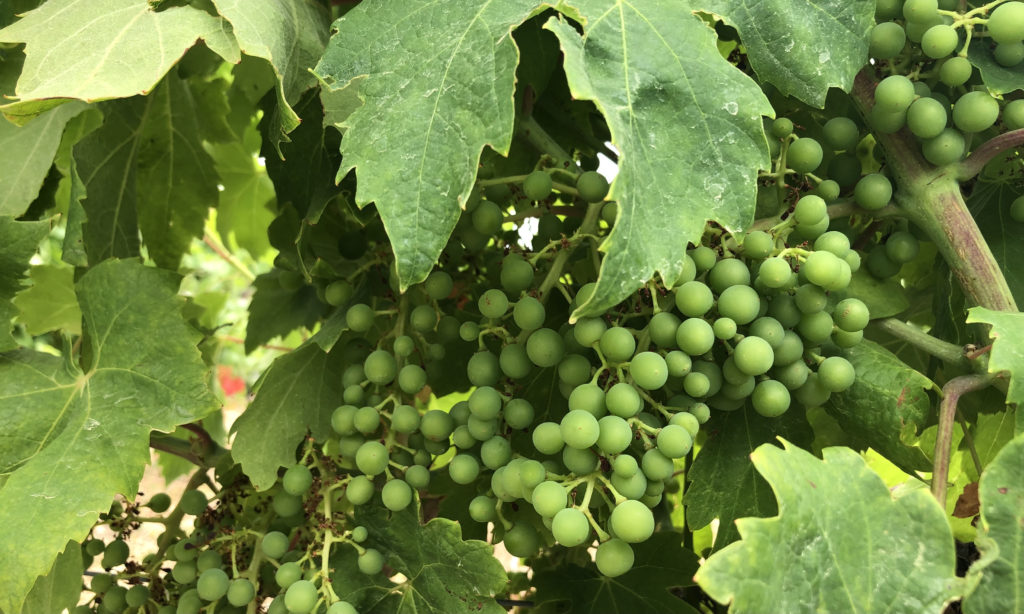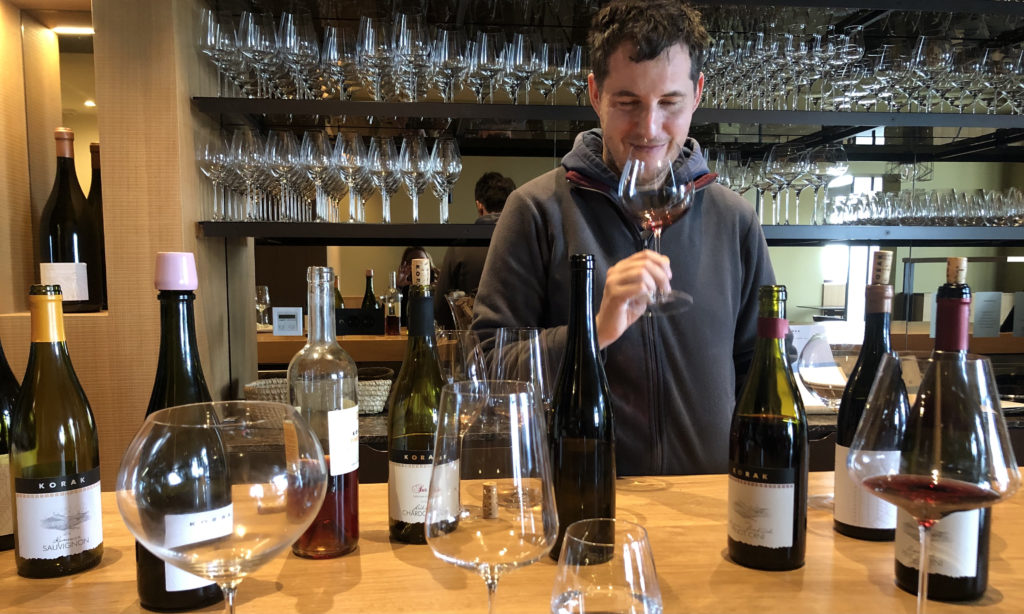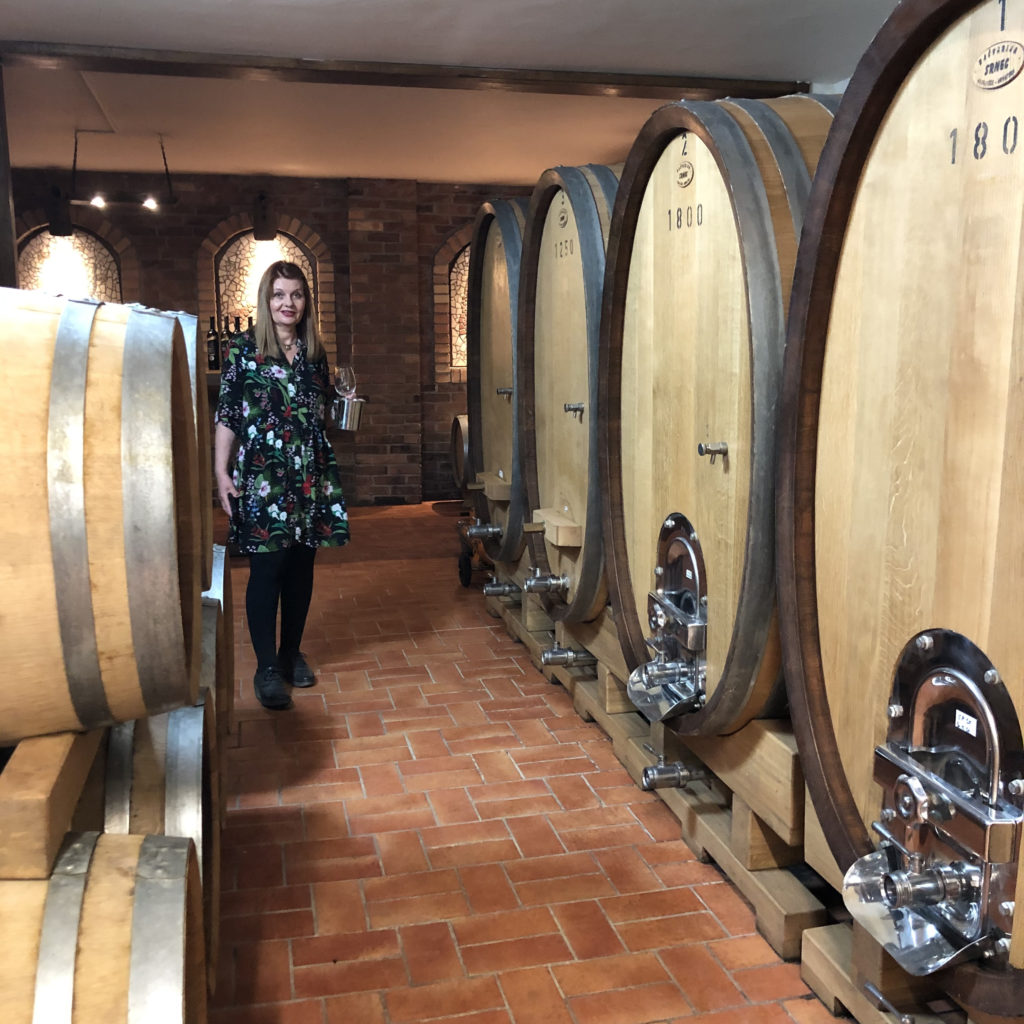This is the seventh in a series of 12 monthly articles following eight Croatian wineries through their year. Catch up on last month’s activities here.
It’s normal in July for Nature to turn up the heat. But across the northern hemisphere this summer, the heat is extreme. Croatia is not suffering the wildfires, water shortages and hellish temperatures that have topped the news in other countries. Still, the unusual heat and dry weather in July have winemakers watching for rain—and thinking about the implications for the timing of harvest and the quality of their fruit if the rain doesn’t come. As harvest approaches, the weather is critical because there is less and less time to correct any problems caused by storms, moisture or lack of water in the vineyard.
Krajančić
Dalmatia is Croatia’s dryest region during summer. “We haven’t had rain . . . I don’t remember. I think the last rain was at the end of May,” says Ivana Krajančić. Normally on Korčula there is some rain at the beginning of June, and growers hope for another dose in mid-July. But so far the vines are managing well—“At the beginning of the year we had lots of rain, lots of water in the vineyards,” Krajančić explains. If it doesn’t rain at all in the coming weeks, though, growers will be worried.
“Right now we think this harvest will be at the beginning of September, which is normal, but then again it’s 15 to 20 days later than the last three, four, even five years,” she says. If the vines don’t get water in the next week or two, they will have to last up to three weeks longer in the dry heat of August.
As in most of Dalmatia, irrigation is not an option. Krajančić has irrigation only in their youngest vineyard, where the less mature vines might not survive without it. “And we are actually the only producer who has an irrigation system in Čara and Smokvica,” says Krajančić. “I think for the other producers it can be a huge problem.”
The heat especially affects Pošip, which has thin skins that are susceptible to sunburn (or conversely, if it rains too much, splitting and rotting). The high vine training system at Krajančic helps cast shade on adjacent vine rows, protecting the fruit.

Plavac Mali is another story. The Plavac vineyard is on a steep slope on the south side of Korčula, tilted to the sun and the sea. This is where the “three aspects of ripening” come into play in places like Hvar, Korčula and the Pelješac. First, the sun beats directly down on the vines, which are trained into low bushes without wires, huddled close to the ground where shade and a drop of moisture might be found. Second, the white stones on the ground help ripen the fruit by reflecting light upwards. Third, sunlight also reflects off the sea below the vineyard. The thicker skins of Plavac Mali can withstand these three angles of sunlight, and the grapes develop full sugar and complex flavors because of it.
This month and next, wine makers will bottle more wine or move it to or from barrels as they make room for the fruit of harvest. Krajančić has just started to use a new, sophisticated lab instrument to analyze the wines.
“Every couple of days I’m analyzing all the stainless steel tanks, all the barrels . . . so we know which one is most ready to bottle,” she says. The instrument measures 22 elements of wine chemistry in about two minutes—things like organic acids, sugars (glucose and fructose) and alcohol content. Krajančić can also use this machine to analyze grape juice before harvest. “For us it was a huge day when this instrument came, because now we can see all the good we are doing in the vineyard. Or all the bad, we don’t know!” The family will offer analysis as a service to other wineries in southern Dalmatia, which will be much faster than sending samples to Zagreb.
Korak

At Korak winery, just west of Zagreb, it is also very hot and dry. “Maybe it’s not such a problem like in Dalmatia,” says Josip Korak, “because we have deep soil.” Moisture may be available for the vine roots deep down. And Korak is cautiously optimistic: “They say next week there will be a little bit of rain. We just don’t want bad weather, like [hail]. Because after these hot days usually we get very bad weather, not just rain but also ice and very windy.” Hail, especially, tears the vine leaves and leaves scars on the grape berries.
In general, though, the vineyard work is letting up. They can’t remove too many leaves from the vines now because they are needed to protect the grapes from sunburn. And although botrytis rot is still a threat, says Korak, “If it’s dry and hot, you don’t need to spray a lot.”
What happens if there is no rain between now and harvest? “The vines will be drier, with smaller berries,” says Korak. But this could turn out to be good. Because of the frost in April, there is less fruit on each vine, so the resources of each vine are devoted to fewer grape bunches. And fewer, smaller berries generally result in a more complex wine.
But if it continues to be hot, says Korak, “We need to be careful in the vineyards to control the pH, sugar, acidity—not to have too-high sugar.” This would create an out-of-balance wine with high alcohol. And if the grapes ripen quickly and harvest is too early, it could raise a different problem. “We’re not happy to harvest in August at 30 degrees [86 degrees F],” he says. “We don’t want hot grapes to come into the cellar—it’s not good for the aromatic profile of the wine.”
The next development in the vineyard will be the coloring of the grape berries. Korak expects to see this at the end of the month for black grapes. “The first week of August they will start changing color,” he says, referring to Pinot Noir and Pinot Gris, which develops a pinkish hue. “In the middle of August they’ll get more juice and [turn softer]. The sugar will come. For sparkling wine we don’t need as much sugar, more acidity. Usually [that harvest is] the end of August. And two weeks after that we’ll start with Chardonnay.”
Antunović
In the Danube region, the weather is milder in summer. Jasna Antunović Turk defines normal as “30 to 32 degrees with slight rain.” But she has noticed a big difference this year. “From mid-June until now, the moisture is high, the temperature is 36, 38, it’s incredible.” Careful planning has helped Antunović avoid mildew and vine stress so far. But the work in the vineyards isn’t over yet.
“The weather forecast is rather hard and heavy rain in the next five or six days,” says Turk. “So today and tomorrow we are spraying, to protect against oidium [mildew], which can cause high damage in July in our region. We are doing it before the rain because who knows what will happen afterwards, and with all this moisture in the air, we don’t want to risk it. So it’s one additional spraying and a little bit more cost.”
The vineyards need a heavy rain because of the heat. The top 10 centimeters of the soil are hot and dry. “Whatever falls first will just evaporate,” says Turk. “It’s better to have a heavy rain so it gets to the root.”
But a good, hard rain is far different from a damaging storm. “That’s the constant danger!” Turk says. “We avoided two storms this year. Because of the Danube I suppose—it’s our protector in this area.” There is something about the position of Erdut’s vineyards inside a switchback of the Danube that seems to discourage storms. “In 20 to 25 years we have a storm, but not each 5 to 10 years like everybody else,” says Turk.

Just as much as the weather, wine makers are focused on the selling season right now. Normally July would be the midpoint of the summer season, but due to Covid, the season started slowly this year. Still, Antunović and most other wineries are making deliveries all over the country, everyday. Like other wine makers, Turk has been traveling to meet with her key accounts, lead tastings and educate consumers. No one knows how the season will turn out, but Turk remains philosophical.
“The impression all over the coast is [that] the season will definitely go longer than usual. But if something happens [with the Covid situation], it will crash the same way it did last year. I’m always very positive and don’t think on bad scenarios, but I honestly don’t know what will be.”
“Anyhow,” she says, “we have enough space for the new vintage in our winery, there is no lack of workers or equipment. We are ready for the new vintage.”
[Title photo: Three sources of light ripen the Plavac Mali grapes at Krajančić on Korčula: from the sun, the stones and the sea. Photo courtesy Krajančić.]

